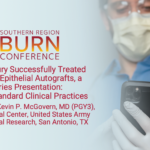Abstract | March 2, 2021
Major Burn Injury Successfully Treated with Cultured Epithelial Autografts, a Case Series Presentation: Establishing Standard Clinical Practices
Learning Objectives
- Identify which patients are candidates for CEA;
- Understand appropriate pre-op and post-op surgical care involved with CEA applications;
- Utilize and disseminate the CPG used at our burn center as a way to improve surgical outcomes across the country.
Introduction: Cultured Epidermal Autografts (CEA) have been an option for coverage of large surface area burns for over two decades. There remains extreme variability in clinical practice in wound bed preparation, application of CEA and postoperative wound care. Communication between the multi-disciplinary team remains the cornerstone of effective management of CEA patients.
Methods: In this case series we examined the medical records of five patients treated with CEA at our burn center over a period from 2015-2018. Operating room times and fluid resuscitation volumes were examined on days when CEA grafting was performed. In order to facilitate meticulous post-operative wound care in a facility where only 1-2 CEA applications are performed per year, a Clinical Practice Guideline (CPG) and Competency Checklist were generated and trialed on a series of nurses and rehabilitation therapists for the five applications of CEA. The CPG and checklist were instituted for pre- and post-operative care.
Results: Amongst the patients treated with CEA, the average TBSA was 80.2% TBSA. The reduction of both intraoperative crystalloid administration and operative case times resulted in improved surgical outcomes with CEA applications. Overall, three of the five patients ultimately survived. Regarding post-operative wound care, the staff reported improved confidence with the utilization of the checklist and valued the CPG as a reference throughout the hospital course.
Conclusions: The Clinical Practice Guideline and Competency Checklist were developed to include specific elements of burn care such as wound bed preparation, meticulous pre- and post-operative wound care, and consistent multidisciplinary communication and planning in the treatment of critically injured patients. The inclusion of the CPG and Checklist into our practice led to the successful outcomes of these CEA applications.
References and Resources
- http://www.epicel.com
- Atiyeh, Bishara S., Costagliola, Michael. (2007) Cultured epithelial autograft (CEA) in burn treatment: Three decades later. Burns. 33 (2007), 405-413
- Wood, F.M. et al. (2006) The use of cultured epithelial autograft in the treatment of major burn injuries: A critical review of the literature. Burns. 32 (2006), 395-401

